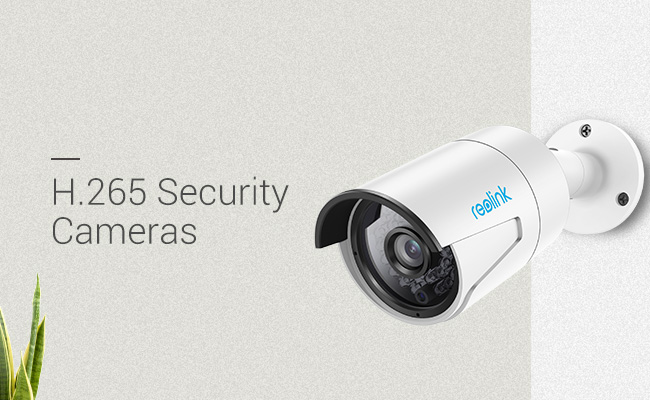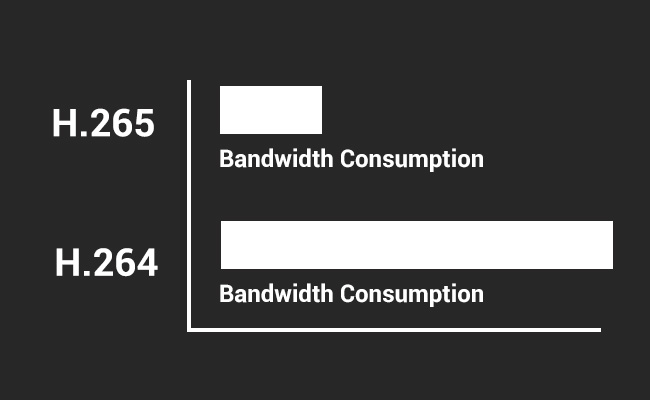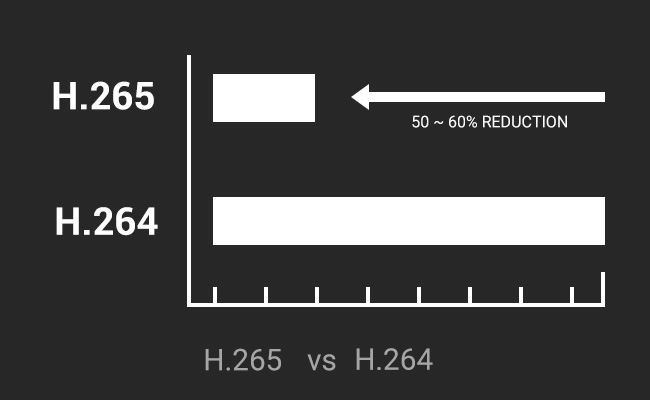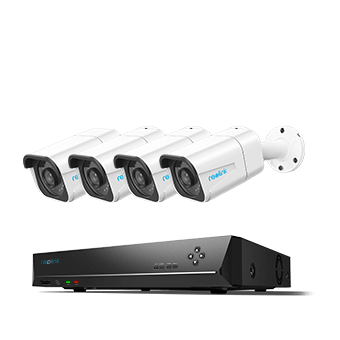Remember those upsetting times when your IP camera delivers "freezing" video feed or hits its storage ceiling in few days?
With H.265 IP cameras, now you can stream high quality videos without eating up too much bandwidth or affecting the performance of other online devices and store the footage in smaller file sizes.
So what are H.265 IP cameras? How can they affect the required bandwidth usage and storage consumption? What are differences between H.265 cameras and H.264 IP cameras? And where can you find the best H.265 security cameras in the market?
To find the answers of all these questions about H.265 IP cameras, please kindly read through this post and leave your comment below if you have any questions or would like to share your ideas with us.
- What Are H.265 IP Cameras
- How Do H.265 Security Cameras Work
- Why Should You Choose H.265 Cameras
- H.265 IP Cameras vs H.264 IP Cameras
- Where Can You Install H.265 IP Cameras
- Should You Buy H.265 Cameras Now or Not
What Are H.265 IP Cameras
H.265 IP cameras are the kind of surveillance cameras that adopt High Efficiency Video Coding (HEVC) or H.265 to encode the video data.
So it begs the following question: what is H.265?
H.265 (named by ITU-T and the numbers contain no special meanings), also called High Efficiency Video Coding (HEVC), refers to an advanced video compression standard that can encode video files twice as efficiently as its predecessor, Advanced Video Coding (AVC), also known as H.264.
H.264 IP cameras, as you can guess, utilize H.264 – one of the most commonly used formats for video recording and compression to provide high quality videos at substantially lower bit rates than previous standards, like MJPEG IP cameras.
In comparison to the H.264 security cameras, h.265 video cameras can double the data compression ratio at the same level of video quality.
This means you can use an H.265 surveillance camera to reduce the bandwidth utilization and storage consumption by about 50% without sacrificing the image quality for various video applications.

Now H.265 security cameras are generally featured with 4K/8MP high resolution and can even support up to 8192 × 4320 pixels. In the world of 1080p and 1440p contents, H.264 security cameras are still the main trend.
How Do H.265 Security Cameras Work
H.265 IP cameras firstly capture the raw footage according to the recording mode you set up, and then encode the videos in H.265 compression after processing the images.
Unlike the H.264 codec that allows for a maximum of 16 x 16 pixel macroblocks to process information, H.265 HEVC security cameras can expand the pattern comparison to sizes up to 64×64 pixel Coding Tree Units (CTUs).
Larger block sizes are more efficient to encode larger frame sizes, like 4K resolution. Other improvements with the H.265 IP cameras, such as improved deblocking filter and motion vector prediction, also contribute to their greater encoding efficiency.
In other words, H.265 CCTV cameras are therefore able to encode videos at the lowest possible bitrate while retaining a certain level of video quality.
Why Should You Choose H.265 Cameras
The advent of H.265 IP cameras has brought great convenience and opened up new possibilities in the security filed.
Why would I say so?
These following advantages of H.265 CCTV cameras will be the best answers.
1. Reduce Bandwidth Usage & Storage Consumption
H.265 IP cameras feature a lower bitrate compared with H.264 and MJPEG security cameras in the same resolution, thanks to their state-of-the-art video compression coding.
Based on the CCTV camera bandwidth calculator and storage calculation formula, lower bitrate will lead to less required bandwidth and storage capacity.
So an H.265 network camera can generally reduce bandwidth consumption and storage usage by about 50% or above. And you no long need to worry that your H.265 camera will slow down your network speed or require too much storage space.
2. Improve Live Feed & Remote Viewing Quality
As H.265 IP cameras take up less required bandwidth, you can expect to get a smooth live feed & remote viewing experience on your smart phones while maintaining the image quality.
For example, you can even stream 4K videos of an H.265 security camera over common network speed without freezing or laggy images.
3. H.265 Surveillance Cameras Offer Better Image Quality
As noted above, H.265 cameras compress information in the Coding Tree Units (CTUs), whose sizes can vary from 4×4 to 64×64, while H.264 allows a maximum block-size of 16×16.
These larger blocks of H.265 IP cameras can mean more accurate information when compressing 4K videos. Thanks to their efficient video compression coding, you'll obtain smooth footage streaming without any frozen or delayed images.
4. Allow for Longer Recording Time
H.265 IP cameras can reduce the required storage usage by about 50%-60%, which means that you'll get smaller file sizes for the recorded footage.
Whether you record the videos to an SD card or to an H.265 NVR, an H.265 security camera can allow for longer recording time before the old videos are overwritten and save you the additional cost to store data, such as paying for the cloud or an external hard disk drive for your NVR.
5. H.265 CCTV Cameras Provide Multiple Streaming Options
In virtue of the efficient video compression coding, H.265 IP cameras provide multiple different resolution streams for your options, supporting a maximum of 8K ultra HD high resolution.
If your network speed and storage space don't allow for such high resolution videos, the h.265 CCTV cameras also allow you to select sub-stream modes to deliver 1440p or 1080p footage.
H.265 IP Cameras vs H.264 IP Cameras
After testing the H.265 IP cameras and H.264 cameras, here we have concluded their main differences from the following aspects:
H.265 CCTV IP Cameras vs H.264 Cameras in Bandwidth Consumption
H.265 IP cameras possess a higher H.265 compression ratio compared with H.264 security cameras.
In the same level of video quality, H.265 PoE cameras can reduce about 50% network bandwidth consumption in transmission and increase streaming speed.

And you may refer to this table below to check out the recommended bandwidth for H.265 security cameras and H.264 security cameras in different resolutions.
|
Resolution
|
Minimum Upload Speed
|
|
|
H.265 IP Cameras
|
H.264 IP Cameras
|
|
|
720p
|
2 mbps
|
5 mbps
|
|
1080p
|
4 mbps
|
8 mbps
|
|
1440p
|
8 mbps
|
16 mbps
|
|
4K
|
15 mbps
|
32 mbps
|
Note: These results are estimated under stable network conditions and may vary with your actual environment and other factors.
H.265 IP Security Cameras vs H.264 Cameras in Storage Usage
As the bitrate is proportional to the required storage usage, H.265 IP cameras with lower bitrate can compress the videos in almost half the file sizes in comparison to H.264 cameras while retaining the original video quality.

H.265 Cameras vs H.264 Cameras in Recording Time Length
Just as mentioned above, H.265 CCTV cameras are packed with a lower bitrate than h.264 IP cameras.
That is to say, with the same storage space, H.265 IP security cameras can allow for longer recording time length before the older files are automatically overwritten. (Learn more about how long security cameras can record.)
H.265 IP Cameras vs H.264 Cameras in Video Quality
By utilizing the CTUs (Coding Tree Units), H.265 cameras incorporate larger blocks to pixels than H.264 IP cameras and these larger blocks are beneficial to compress larger frame sizes.
So H.265 IP cameras are more suitable to produce higher resolution images and videos, such as 4K and 8K ultra HD footage, with less bandwidth usage and storage consumption.
H.264 cameras, on the other hand, are a better option to offer you 1080p/1440p/5MP videos.

Where Can You Place H.265 Surveillance Cameras
H.265 IP cameras are suitable for a wide range of applications – indoors & outdoors, for home & business, such as your front door, back door, garden, garage, shop, constructions sites, schools, hospitals, bars, etc.
And the H.265 CCTV cameras are especially ideal for delivering ultra HD videos with the high-efficiency video compression coding, such as 4K and 8K.
Indeed, some reputable security camera brands, are already providing or plan to provide 4K H.265 cameras to stream clearest ever videos with less network consumption and storage usage.
If you need to monitor large areas with minimal bandwidth usage and storage consumption, a 4K H.265 security camera system can also meet your needs with an H.265 NVR included for long-time video storage.
Should You Buy H.265 Cameras or Not
H.265 IP cameras are gaining increasing attention now with the growing demand of video streaming in high resolution and 4K devices, such as 4K TV and monitors arriving in succession.
It is undeniable that H.265 IP cameras offer you a more efficient way to stream and store videos, but do you actually need an H.265 security camera for your application?
It depends.
As H.265 CCTV security cameras are relatively new in the security camera field, it is no surprise that they are hard to find still. And their higher price is also an important factor you should consider.
Besides, H.265 IP cameras are basically designed to deliver 4K/8MP ultra HD high definition videos, so they can only be brought into full play when greater details are required or when you need to monitor large areas, like your shared driveway, backyard, construction sites, etc. (Read this post to select a H.265 4K outdoor security camera.)
If you need to cover relatively smaller areas and have a relatively tight budget, H.264 security cameras would be enough for you to produce 5MP/1440p/1080p videos with some details included, like human face features, license plate numbers, etc. (Click here to get multiple H.264 security camera options.)
Watch the video below captured by an H.264 security camera, Reolink RLC-410.
Update: Aside from H.264 and H.265 compression code, there is also another compression code for you to choose from, which is H.264+. For example, Reolink has launched its first 4K security camera system, RLK8-800B4, which can capture videos in 8MP ultra clear image quality with H.264+ compression technology. With this security kit, you can watch everything around your property clearly without using up the storage space.
4K 8-Channel PoE Security System
4 pcs 4K Ultral HD Security Cameras; 2TB HDD 8-Channel NVR for 24/7 Recording; Plug & Play; 2 Network Solutions.
So what are your thoughts about the H.265 IP cameras? Will you consider buying one for your home or business? And do you still have any questions about H.265 cameras? Please leave your comment below and we'd like to discuss more with you.




You have an article on H265 but you don't appear to sell H265 – very clever.
Hi there, yes, we don't sell H.265 security cameras now, but we are devoted to sharing the newest trends in the security camera filed with our readers. And FYI, we already have the plan to develop H.265 IP cameras this year. If you interested to buy them in the future, please stay tuned with us!
will older cameras be able to use H.265 with a firmware update?
Hi, there, as I have mentioned in the post, H.265 video coding is often found in the 4K security cameras. While older cameras usually utilize MJPEG or H.264 codec and they can't use H.265 with a firmware update.
well technically you can if existing cameras have GPUs, even if they don't you still could by forcing a limit on the number of concurrent client streams to save resources... but even then if the webserver is something like node.js with express then you can create a large number of client streams without much consequence.
So if the current CPU use for a camera is below 20% for the creation of h.264 or mjpeg then you can totally get away with h.265 with a simple update.
The resolution is irrelevant. It is a compression method for video, it can be a lower resolution if you wanted it to be.
(i work with FFmpeg and Node.js all day, all week)
why did you ask if you thought you knew the answer already? The gpu's in the 264 cameras do not support the 265 algorithm so as she said, no its not possible the hardware has to support it.
I didn't know the answer. The hardware being capable makes no difference if their developers won't add the feature set in the software (not sure how that is hard to understand, not everyone does something because they can)
You don't need a GPU to encode H.265. CPU can do it alone. I never said they HAD to use the GPU. Maybe I could have worded it better so you'd not assume i meant all GPUs are the same.
I have an Acer Aspire laptop with some dinky Intel Atom 1.6Ghz. That thing is capable of encoding H.265 for one stream. Obviously this would be bad on the hardware but it does make it possible.
very well written article.What would be the upload( not download ? ) bandwidth required for a IP Camera – H.255 ? After installing the IP camera if my upload bandwidth is inadequate then what happens ?
Hi there, the bandwidth required for an IP camera can be determined by various factors, including the resolution, video compression codec, etc. You may refer to this guide to calculate the rough required bandwidth, https://reolink.com/ip-camera-bandwidth-calculation/. And if the upload bandwidth is inadequate, the uploading speed will be rather slow. But you may adopt the methods in the link above to optimize your IP camera bandwidth consumption. Hope this will help solve your problems.
I am sold on h.265! Thank You. However, since Reolink does not make h.265 cameras, I bought them from my Chinese supplier.
Hi, David, glad this post helps. And actually we do have plan on selling H.265 IP cameras this year. If there is any progress, I'll update the info here. Please stay tuned!
Cuándo van a sacar las cámaras con H.265? Ya va a terminar el año
Hi, there, we are about to launch H.265 camera systems soon (the specific date remains to be determined). Please stay tuned and you'll be informed as soon as they are available.
Hi, Miss Jenny Hu.
Very very interesting post.
I have always been convinced that your products are really good, and it would be very nice if for this your camera model Reolink RLC-422W and not only, you could add some improvements like these:
– (1) Upgrade camera effective pixel resolution from 5.0 Megapixels to 8.0 Megapixels;
– (2) Upgrade camera protection from IK10 to IK10+
– (3) Upgrade video codec compression from H.264 to H.265;
– (4) Upgrade mainstream frame rate from 20 to 20/30/40;
– (5) Upgrade WiFi (2.4 GHz & 5 GHz – MIMO antennas 2T2R) from IEEE 802.11a/b/g/n to IEEE 802.11a/b/g/n/ac;
– (6) Upgrade IR distance from 30 Meters (100ft) to 40 Meters (130ft);
– (7) Upgrade WiFi security from WPA-PSK/WPA2-PSK to WPA-PSK/WPA2-PSK/WPA2-CCMP
– (8) Upgrade camera for facial detections;
– (9) Upgrade and improve the Android & IOS App;
– (10) Upgrade and improve the camera firmware;
– (11) Upgrade and improve the camera power consumption.
If you make these upgrades your products will become the best ever on the market !
I await your answer to know which of these upgrades you have on site in your roadmap for the launch of new and better products for the year 2019.
Thanks in advance for the support.
Hi, Fabio, thank you so much for your helpful suggestions. And I'll definitely forward them to our R&D team. Just for your information, we do have plans to launch 8MP security cameras with H.265 video compression codec this year. Plz stay tuned with us for the latest progress!
If I get a h.265 camera, does that mean that I got to have newer CPU/GPU/mobile that supports hardware h.265 in order to watch the video over the internet? What else would I need to have it record on cloud memory for at least couple of days?
Hi, there, after you have installed the security camera App or Client, you can watch the video of H.265 IP camera over the Internet without the need to have newer CPU/GPU/mobile. If you are looking for cloud service, you should first confirm whether your H.265 security camera support cloud service. If not, you can consider storing images or videos in SD cards. Hope it helps.
Yes, you've been helpful. Thank you.
Hi, there, thank you for your great interest in our new product. Please subscribe to us and we will inform you once it is available.
So where is the 265 unit? Or will there be an update for the current units to use this new format?
Do you have any devices that can use the H.265 as yet and will there been an update for older devices to use this codec?
Hi there, we're about to launch the H.265 security camera systems very soon. Pleased stay tuned with us for the latest progress!
I definitely would like to see Reolink start making h265 cameras. The reduction in file size means you can retain video for longer with the same amount of storage which is a huge deal. I have a RLC-410 5MP and it is perfect in every way except for 2 things: no h265 and the video aspect ratio is 4:3 instead of 16:9 at the max resolution (that's not a huge deal). It is hard to find a decent and reasonably priced bullet camera above 1080p with a built in mic and h265 recording. Currently I have two "hacked firmware" Dahua cams on order which supposedly fit these requirements, but if Reolink could make a legit bullet PoE IP camera that's 4MP+, with a built in mic, h265 encoding, and under $100 then I'd probably order at least 5 of them right away. (Assuming I don't finish my project using other cameras first!)
Hi, Matt, thank you for your great support. We are about to launch H.265 security camera systems very soon. Please stay tuned with us!
Will your H.265 cameras work with your 8CH and 16CH NVRs or is a new NVR going to be required?
Hi there, our H.265 IP cameras will work with the new NVRs with upgraded firmware. Hope this helps.
Hi
Will your new h.265 cameras have the same IR functionality as teh current ones? I use 2 RL cameras and they have a great night view compared with my other h265 cameras from another big vendor. Therefore I plan to replace those h265 cameras with the new RL h.265
Thanks Daniel
Hi Daniel, of course yes! We have launched an 8MP security camera system, which comes with sharp images and excellent night vision just the same as the current Reolink IP cameras for sale! You may check here https://reolink.com/product/rlk8-800b4/ to learn more detailed information. Thank you for your support. 🙂
Hi Jenny
That's good news. But is that a h.265 camera? I coudln't find that in the specs. Ans do you plan a 16ch NVR as well as I need 10 cameras in total
Hello, Ardi, you can only connect our H.264 security cameras to a laptop via Ethernet cables. Click here https://reolink.com/connect-security-ip-camera-to-pc/ to learn more on how to connect a security camera to your PC. Hope this helps.
So what's the status of h.265 cameras and system? You have been saying for over a year that it is coming soon.
Hi Mark, we are sorry that we don't have any updates on h.265 cameras and systems to share with you as of now. But we have already launched 4K cameras and systems with H.264+ compression code already and you may click here to learn more, https://reolink.com/product/rlk8-800b4/.
Is it only the 4k model that offers H.264+ compression? Do other models offer this as well?
Hi Mark, only 4K model offers H.264+ compression as of now. Also, we will take your suggestion into account and keep you updated if we have any news on the H.264+ and H.265 compression. 🙂
Hi bob, we don't have any news on H.265 cameras and systems to share with you as of now. But we have already released 4K cameras and systems with H.264+ compression and you may find more detailed info here, https://reolink.com/product/rlk8-800b4/.
Hi there, we don't have any plans to release security cameras or systems with H.265 in the near future. If there are any updates, we will let you know. 🙂
Hi John, we are sorry for the inconvenience caused. We have adjusted our product plan and postponed the official launch of H.265 cameras. But we have released a 4K security system (and other two to come) that supports H.264+ compression code. You may click here to learn more, https://reolink.com/product/rlk8-800b4/. If there are any updates on the H.265 cameras, we will let you know. 🙂
Jenny that link takes me to Reolink page with 4K system. But it mentions NOTHING about H.264+ compression. Are you saying that your 4K cameras and 4K compatible NVR use the H.264+ compression code as of right now?
Hello there, in fact, we have upgraded our 4K system with H.265 compression. But we are still working on the copyright issues so we may not mention that on our product page. We will update the product page later when we receive the H.265 license. If there is any other news, we will let you know. 🙂
So, just to be absolutely CLEAR. If I buy a current 4K system from your website, I will be getting H. 265 compression (not 264). Is this correct??
Hi there, sorry for the late reply. That's correct.
So, just to be CRYSTAL CLEAR...if I purchase a new 4K system from your website, I will be getting the NEW H.265 compression rate and NOT the 264? Just checking, bc I plan on buying really soon.
Hi there, that's correct. Please let us know if you have any additional questions.
When will 4K cameras support higher resolution with rtsp? Currently can only use _sub stream which is 640×340 resolution. If like to get the _main or full 4K resolution and h.265 with rtsp.
”Note: the 4k cameras connected with the 4k nvr system will only show fluent live stream instead of the clear live stream due to the H.264+(h.265) limit.”
Source:
https://support.reolink.com/hc/en-us/articles/360007010473-How-to-Live-View-Reolink-Cameras-via-VLC-Media-Player
Hi Mark, thank you for reaching out. The specific date for 4K cameras to stream higher resolution with RTSP still remains to be determined. Note that we do plan to upgrade our 4K cameras and systems to show clear live stream in higher resolution. Stay tuned with us!
Hi! Just received RLK8-800B4. Updated base and cameras. Is this already h.265?( Please see attachments) https://uploads.disquscdn.com/images/4c0105b2d3db49f7ee761b87724e506940bb26187df3f7c4ec9b1683f3109947.jpg
I was waiting for new Reolink's h.265 cameras. It looks that it was waste of time. I've bought few Hikvision cameras, and i am really happy (H.265+ is fantastic).
Reolink's product strategy seems a bit odd here. I found this post while shopping for additional cameras. I already use RLC-410 and have been happy, but I have to have it recording on the high quality stream at a fairly high framerate to be of any use. I couldn't get the motion detection on either the camera or my Synology to work well enough that I could switch to higher quality only when motion is detected.
So adding additional cameras means that bandwidth and storage become high priority criteria.
Worth adding something about the nature of this blog post. I chose Reolink originally after finding competing cameras did not deliver on their claimed specs. That built loyalty to Reolink and my preference for additional cameras was Reolink. I find this blog post is disingenuous. It is not until the comments that Reolink states that your cameras don't do h.265. A more casual shopper might assume because you were extolling the virtues of h.265, that your cameras offer this. One might conclude that this was your intention. A shame.
Hello Shahab, both the D800 camera and 4K NVR support H.265 video format. NVR with older hardware support H.264 video format only and that's why it shows H.264 in the specs. Simply put, if an NVR works with the B800/D800 cameras, it supports H.265. Hope this clarifies.
Hi! Just received RLK8-800B4. Updated base and cameras. Is this already h.265?( Please see attachments) Thanks! https://uploads.disquscdn.com/images/4c0105b2d3db49f7ee761b87724e506940bb26187df3f7c4ec9b1683f3109947.jpg
Hello Vladimir, yes, it is already h.265. High Efficiency Video Coding (HEVC) is also known as H.265. Hope this helps.
Hello Vladimir, yes, you can add D800 camera to your RLK8-800B4 system and the D800 camera also comes with h.265 video format. 🙂
Hi Angel. Yes, you need the power supply for cameras, unless they are battery-powered cameras. If you would like to have battery-powered H.265 cameras, Argus 3 2K, Argus 3 Pro, and Argus PT 2K are good choices.